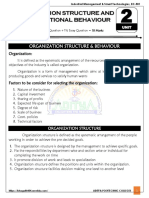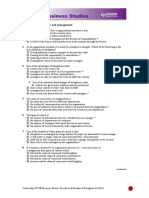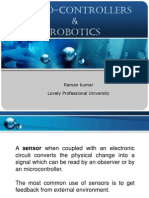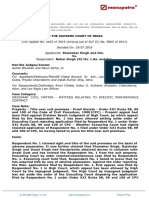Organization Structures 3.1 Definitions
Organization Structures 3.1 Definitions
Uploaded by
anishvanchaCopyright:
Available Formats
Organization Structures 3.1 Definitions
Organization Structures 3.1 Definitions
Uploaded by
anishvanchaOriginal Description:
Original Title
Copyright
Available Formats
Share this document
Did you find this document useful?
Is this content inappropriate?
Copyright:
Available Formats
Organization Structures 3.1 Definitions
Organization Structures 3.1 Definitions
Uploaded by
anishvanchaCopyright:
Available Formats
Organization Structures 3.
1 Definitions: Organization is the structural frame work of duties and responsibilities required of personnel in performing various functions with a view to achieve business goals. Organization Chart is a graphical representation of the structural relationship among the different functions (departments) and positions (Persons) in an enterprise. 3.2 Advantages of organization charts: 1. Shows the relationship among the employees. 2. Shows the flow of authority of various persons. 3. Shows the various departments and their functions. 3.3 Principles of Organization: 1. 2. 3. 4. 5. 6. 7. 8. 9. 3.4 Consideration of objectives Relationship of basic components of the organization Responsibility and authority Span of control Division of work Effective delegation communication Line and staff relationship Balance, stability and flexibility
Types of organization Structures: 1. Line Organization 2. Functional or staff Organization 3. Line and Staff Organization
3.5
Line Organization ( Scalar organization ) 1. It is characterized by direct lines of authority flowing from the top to bottom 2. The lines of responsibility flows from bottom to top 3. The business activities are divided into different departments and put under the control of departmental heads 4. Departmental head directs and controls one or more managers : Managers control supervisors or foremen : foremen control a group of workmen. 5. No operation is under two bosses. 6. This is also known as military type of organization. GM
Finance Manager
Sales Manager Manager
Head, Production Manager
Personnel Manager Manager Manager Manager Manager foreman workmen foreman workmen
Foreman workmen
Foreman workmen
3.5.1
3.5.2
Line Organization chart Merits: 1. Simple to understand and operate 2. Well defined authority and responsibility 3. Better coordination 4. Effective communication 5. Economical 6. Quick decisions Demerits: 1. Excess work for the heads 2. Lack of specialization 3. Lack of coordination among departments 4. Distortion of communication
7. Unity of command 8. Effective supervision 9. Executive development 10. Flexibility 11. Strong discipline 5. Lack of initiative 6. Favoritism 7. Instability 8. No means of rewarding good workers
3.5.3
Application: 1. For small and medium factories 2. For continuous process industries such as sugar, paper, refineries etc. 3. For automotive plants. 4. For concerns where labor problems are less and easy to handle.
3.6.
Functional organization: F.W Taylor developed the concepts of functional Organization and it is also known as Taylors functional organization. 1. The difficulty in finding all round qualified persons to work in line organization is overcome by this type of organization. 2. The person in-charge of a function is a specialist in it and brings out the best in him self. 3. The supervisory functions are divided into Two groups. 1. Office Specialist 2. Shop floor specialist. 1. Route clerk 1. Gang boss 2. Instruction clerk 2. Speed boss 3. Time & cost clerk 3. Repair boss 4. Disciplinarian 4. Inspector Advantages: 1. Specialization 5. Relief to top executives 2. Increase in efficiency 6. Economy of operations 3. Scope for growth 7. Better supervision 4. Flexibility 8. Democratic control Disadvantages: 1. Conflict in authority 5. Poor discipline 2. Lack of coordination 6. Expensive 3. Difficulty in fixing responsibility 7. Group rivalries 4. Delay in taking decisions Application: 1. Due to many disadvantages this form is obsolete. However modified versions are in use. 2. Suitable for medium and large manufacturing concerns. 3. Expanding industries.
3.6.1
3.6.2
3.6.3
Works manager
Office
Instructi on
Shop floor
Route Clerk
Clerk
Time Clerk
Disciplinarian & cost clerk
Gang Boss
Speed Boss
Repair
Inspector
Boss
Workmen Functional Organization Chart
Workmen
3.7.
3.7.1
Line and Staff Organization 1. It is a happy blending of line and functional organization. 2. The line executives retain their executive authority and control over the work of their subordinates. 3. The staff executives are attached to the line managers to advise them on the matters related to their specialized field. 4. The final decision remains with the line executives whether to accept and implement the recommendations of the staff or not. 5. The line officers have authority and are responsible for the accomplishment of the objectives. 6. Staff officers have responsibility and authority for providing advice and service to the line officers in the attainment of the objectives. Advantages: 1. 2. 3. 4. 5. 6. 7. 8. Specialization without affecting the unity of command No confusion in authority and responsibility Better discipline Growth and expansion Line executives are relieved from some burden Better quality Quick action Enjoys the advantages of both Line and Functional organizations 4. Ineffective staff 5. Lack of coordination 6. Expensive
3.7.2
Disadvantages: 1. Conflicts between line and staff personnel 2. Lack of responsibility for staff members 3. More dependence on staff
BOD Secretary Legal adviser
GM
AM IE foreman workmen Pur.M Superintendant foreman workmen WM SM Superintendant foreman Workmen PM Design engr. foreman Workmen
Line and staff organization
3.8
Line, staff and Functional Organization 1. As regards to discipline and output are concerned, the workers are kept under direct control of foreman. 2. As regards the quality, the inspector has the proper authority to control the quality and he can directly order the workmen. 3. As staff relationship, there may be research department for the analysis of the materials, semi-finished and finished products.
GM Research Engineer Works Manager IE
Foreman
Foreman
Inspector
Workmen
Workmen
Organization chart
You might also like
- Office OrganizationDocument8 pagesOffice OrganizationzackserickNo ratings yet
- Types of OrganizationsDocument11 pagesTypes of OrganizationsmalcomNo ratings yet
- G9 Developing Effective OrganisationDocument8 pagesG9 Developing Effective OrganisationWanda DhaputNo ratings yet
- Wom Unit 2Document8 pagesWom Unit 2Arush Arka GhoshNo ratings yet
- Organizing, Leading and ControllingDocument41 pagesOrganizing, Leading and ControllingDarshan MNo ratings yet
- Chapter 7 Organisation and ManagementDocument6 pagesChapter 7 Organisation and Managementtaj qaiserNo ratings yet
- Chapter 7 Organisational Structure NotesDocument7 pagesChapter 7 Organisational Structure NotesvotfsoulNo ratings yet
- Organizational DesignDocument6 pagesOrganizational DesignsimranNo ratings yet
- 10976admin Post Strat 1Document52 pages10976admin Post Strat 1Vasanth VasuNo ratings yet
- Types of Management StylesDocument4 pagesTypes of Management StylespriyanshuNo ratings yet
- Chapter - : Forms of OrganisationDocument4 pagesChapter - : Forms of OrganisationManjunath HrmNo ratings yet
- Organ in SingDocument55 pagesOrgan in SingArvind MallikNo ratings yet
- Organization StructureDocument13 pagesOrganization Structuregarima khantwalNo ratings yet
- Types of Organizational StructureDocument9 pagesTypes of Organizational StructureRodin RamosNo ratings yet
- Chapter 7 Organisation and StructureDocument5 pagesChapter 7 Organisation and Structure123vinayakagarwalwowNo ratings yet
- Internal Org - 1Document11 pagesInternal Org - 1Shantejah MitchellNo ratings yet
- OB Module 5Document19 pagesOB Module 5Anal k LalNo ratings yet
- Definitions of Organizational StructureDocument3 pagesDefinitions of Organizational StructureCocoNo ratings yet
- Organizational ManagementDocument10 pagesOrganizational ManagementSk jahidul IslamNo ratings yet
- P1Bab01 Essentials of Management: Vel Tech DR - RR & DR - SR Technical University Department of MbaDocument16 pagesP1Bab01 Essentials of Management: Vel Tech DR - RR & DR - SR Technical University Department of MbadivyaimranNo ratings yet
- CHAPTER 2 Designing The Organizational StructureDocument5 pagesCHAPTER 2 Designing The Organizational StructureJames Paul RaquelNo ratings yet
- Organizational StructureDocument8 pagesOrganizational StructureShakti AwasthiNo ratings yet
- Bussiness PresentationDocument8 pagesBussiness Presentation2257010008No ratings yet
- M M M M MDocument23 pagesM M M M MMilan PitrodaNo ratings yet
- Presentation 2 - Designing The Organizational StructureDocument17 pagesPresentation 2 - Designing The Organizational Structuregel.silvestre23No ratings yet
- Section 2 - Internal Organisation EnvironmentDocument24 pagesSection 2 - Internal Organisation Environmentstevinfisher8No ratings yet
- Organization Structure (Unit 3 Notes)Document104 pagesOrganization Structure (Unit 3 Notes)ParakramNo ratings yet
- Line and Staff Organization Is A Modification of Line Organization and It Is More Complex Than Line OrganizationDocument3 pagesLine and Staff Organization Is A Modification of Line Organization and It Is More Complex Than Line OrganizationRamchandra MurthyNo ratings yet
- Entrepreneurship and Start-Ups 03600201: Lecturer-Applied Science, Diploma StudyDocument85 pagesEntrepreneurship and Start-Ups 03600201: Lecturer-Applied Science, Diploma StudySMIT CHRISTIANNo ratings yet
- Organizational Structure DesignDocument40 pagesOrganizational Structure DesignPawan Kinnal100% (1)
- Module 3 - Organization and ManagementDocument20 pagesModule 3 - Organization and ManagementyangNo ratings yet
- Determinants of Organizational StructureDocument57 pagesDeterminants of Organizational StructureAmit89% (9)
- Class 12 BSTD Poonam GandhiDocument44 pagesClass 12 BSTD Poonam GandhimayurqnaNo ratings yet
- Line OrganizationDocument8 pagesLine OrganizationGirlie Faith Morales BrozasNo ratings yet
- Unit 7: Organization and Management: Advantages of An Organizational ChartDocument5 pagesUnit 7: Organization and Management: Advantages of An Organizational ChartNe PaNo ratings yet
- Organization StructureDocument21 pagesOrganization Structurevinaycool12344150100% (1)
- Organizing Technical ActivitiesDocument5 pagesOrganizing Technical Activitiessmangondato230No ratings yet
- Introduction To ManagementDocument20 pagesIntroduction To ManagementAmilda StewartNo ratings yet
- Imst 2Document18 pagesImst 2satyaNo ratings yet
- IGCSE Business 7 TestDocument3 pagesIGCSE Business 7 Testafzana.alsharqyiaNo ratings yet
- Chapter 1 Introduction To Management OrganizationsDocument25 pagesChapter 1 Introduction To Management OrganizationsBhawish RameshNo ratings yet
- Unit 3Document90 pagesUnit 3Nitish GuptaNo ratings yet
- Forms of Organizations (Based On Structure)Document33 pagesForms of Organizations (Based On Structure)D Well WisherNo ratings yet
- Principles of Management NotesDocument94 pagesPrinciples of Management NotesPraneet RajNo ratings yet
- Impact of Information Systems On Organizational StructureDocument4 pagesImpact of Information Systems On Organizational Structurekavees.20231704No ratings yet
- Chapter OutlineDocument7 pagesChapter Outlinele_kien_31No ratings yet
- Front Office NotesDocument10 pagesFront Office Notespollyne josephNo ratings yet
- 2 Levels of MGMT 2 2Document10 pages2 Levels of MGMT 2 221CCU199 Nithya Priya . MNo ratings yet
- Industrial PsychologyDocument4 pagesIndustrial PsychologyJeremiah SuarezNo ratings yet
- Chapter 4 Organizing Technical ActivitiesDocument28 pagesChapter 4 Organizing Technical ActivitiesNonoe FelixNo ratings yet
- Organistion and ManagementDocument5 pagesOrganistion and ManagementmielatmiluNo ratings yet
- 3.typology of OrganisationDocument15 pages3.typology of OrganisationVishal Singh JaswalNo ratings yet
- What Is Organisational Structure?Document22 pagesWhat Is Organisational Structure?SummyyaNo ratings yet
- Changing Nature of Managerial WorkDocument10 pagesChanging Nature of Managerial WorkakramNo ratings yet
- UNIT 1 Organization and Its EnviornmentDocument6 pagesUNIT 1 Organization and Its Enviornmentharsh hariharnoNo ratings yet
- Line and Staff OrganisationDocument7 pagesLine and Staff Organisationfousan66No ratings yet
- Organization and ManagmentDocument9 pagesOrganization and ManagmentMariyam IfhamNo ratings yet
- Presentation 1Document90 pagesPresentation 1taj qaiserNo ratings yet
- A Pragmatic Introduction to Middle Manager Fundamentals: Part 2 - Managing at a DistanceFrom EverandA Pragmatic Introduction to Middle Manager Fundamentals: Part 2 - Managing at a DistanceNo ratings yet
- Excelling as a Team Leader: Helping Team Members & the Unit Be Best in FieldFrom EverandExcelling as a Team Leader: Helping Team Members & the Unit Be Best in FieldNo ratings yet
- Linear Control Systems - B. S. Manke - SolutionsDocument251 pagesLinear Control Systems - B. S. Manke - Solutions4k4you25% (8)
- Jest SyllabusDocument1 pageJest SyllabusanishvanchaNo ratings yet
- Black Holes TodayDocument11 pagesBlack Holes TodayanishvanchaNo ratings yet
- Unit3 PPCDocument7 pagesUnit3 PPCanishvancha0% (1)
- Unit4 ORDocument6 pagesUnit4 ORanishvanchaNo ratings yet
- Microcontroller With IR SensorsDocument31 pagesMicrocontroller With IR Sensorsanishvancha100% (4)
- Network Diagrams 1.0 Network DiagramDocument5 pagesNetwork Diagrams 1.0 Network DiagramanishvanchaNo ratings yet
- Unit2 Work StudyDocument14 pagesUnit2 Work StudyanishvanchaNo ratings yet
- Materials Management 1.0 DefinitionDocument4 pagesMaterials Management 1.0 DefinitionanishvanchaNo ratings yet
- Inspection & Quality Control 1.0 DefinitionDocument12 pagesInspection & Quality Control 1.0 DefinitionanishvanchaNo ratings yet
- 6835 Bio Medical InstrumentationDocument2 pages6835 Bio Medical InstrumentationanishvanchaNo ratings yet
- Functions of ManagementDocument8 pagesFunctions of ManagementanishvanchaNo ratings yet
- Solar TrackerDocument3 pagesSolar TrackerTarun Kumar ReddyNo ratings yet
- ZONE 15 - Super Markets & Grocery PDFDocument5 pagesZONE 15 - Super Markets & Grocery PDFKaushik RaviNo ratings yet
- Hematology Controls: + Instrument Parameter Low Normal HighDocument4 pagesHematology Controls: + Instrument Parameter Low Normal HighBenn BasilNo ratings yet
- Railway Engineering Lecture 1Document17 pagesRailway Engineering Lecture 1Moin KhanNo ratings yet
- CH 2 - Hashing and Priority Queues HashingDocument112 pagesCH 2 - Hashing and Priority Queues HashingBarnoota Komputeraa afaan oroomonNo ratings yet
- Heckle Plot (Autosaved)Document10 pagesHeckle Plot (Autosaved)Prince RathoreNo ratings yet
- Digital Transformation of TransportDocument22 pagesDigital Transformation of TransportMaryam MeryNo ratings yet
- Zzzsimbologia Neumatica Iso 1219-1-1Document103 pagesZzzsimbologia Neumatica Iso 1219-1-1Maciu LumiNo ratings yet
- MarkStrat Round 6 Decisions Team A Section B (Redo)Document3 pagesMarkStrat Round 6 Decisions Team A Section B (Redo)MeetNo ratings yet
- Organizational Politics and PowerDocument23 pagesOrganizational Politics and PowerMichael Valdez100% (1)
- Xometry Test Part Guidelines and Instructions - V8 - June 2022Document4 pagesXometry Test Part Guidelines and Instructions - V8 - June 2022Ricardo LopezNo ratings yet
- Nursing Care PlanDocument2 pagesNursing Care PlanSiena KaleiNo ratings yet
- T50Document48 pagesT50Apep Taofik HidayatNo ratings yet
- Coils ConnectorsDocument20 pagesCoils ConnectorsВладимир БлискунNo ratings yet
- Senior Software Engineer - 231020134706 PDFDocument2 pagesSenior Software Engineer - 231020134706 PDFTrail TestingNo ratings yet
- Configuracion ME4012Document7 pagesConfiguracion ME4012haflores2512No ratings yet
- Perineural Adjuncts For Peripheral Nerve BlockDocument7 pagesPerineural Adjuncts For Peripheral Nerve BlockpitriaNo ratings yet
- Lab Sheet 3Document5 pagesLab Sheet 3SIDDHARTH DESHMUKHNo ratings yet
- DHS-7952A-ENG : Yearly In-Service Training RecordDocument2 pagesDHS-7952A-ENG : Yearly In-Service Training RecordHudeyfaNo ratings yet
- 1-AMEX Express USA Juan Valeriano 2021 12 29 211229 134704Document4 pages1-AMEX Express USA Juan Valeriano 2021 12 29 211229 134704Fdhh Sf54gNo ratings yet
- Any Bachelor Degree of 3/4/5 Years Duration: Preserve The Registration Number For All Future CorrespondenceDocument1 pageAny Bachelor Degree of 3/4/5 Years Duration: Preserve The Registration Number For All Future CorrespondenceRanjith KumarNo ratings yet
- Materials and Design: R. Jeya Girubha, S. VinodhDocument9 pagesMaterials and Design: R. Jeya Girubha, S. VinodhEdwin CMNo ratings yet
- 11.republic vs. The Estate of Virginia SantosDocument4 pages11.republic vs. The Estate of Virginia SantosDONNIE RAY SOLONNo ratings yet
- The Elim Connection, August 2023Document11 pagesThe Elim Connection, August 2023BENCHER MUSHEMEZANo ratings yet
- Restaurant IndustryDocument5 pagesRestaurant Industryislafab25No ratings yet
- Unit 3 Modelling and EvaluationDocument40 pagesUnit 3 Modelling and EvaluationYash DesaiNo ratings yet
- QUALITYMANAGEMENTFORRMGs AQUALITYGATECONCEPTCRPDocument13 pagesQUALITYMANAGEMENTFORRMGs AQUALITYGATECONCEPTCRPropeaccessutmjobsNo ratings yet
- Measurement and Scaling: Fundamentals and Comparative ScalingDocument26 pagesMeasurement and Scaling: Fundamentals and Comparative ScalingPrateek KhannaNo ratings yet
- Safety Risk Registers: Challenges and Guidance: Chemical EngineeringDocument6 pagesSafety Risk Registers: Challenges and Guidance: Chemical EngineeringBineeshNo ratings yet
- Epidemiologi DialipidemiaDocument5 pagesEpidemiologi DialipidemianurfitrizuhurhurNo ratings yet
- Shamsher Singh and Ors Vs Nahar Singh PDFDocument14 pagesShamsher Singh and Ors Vs Nahar Singh PDFSatamita GhoshNo ratings yet






































































































